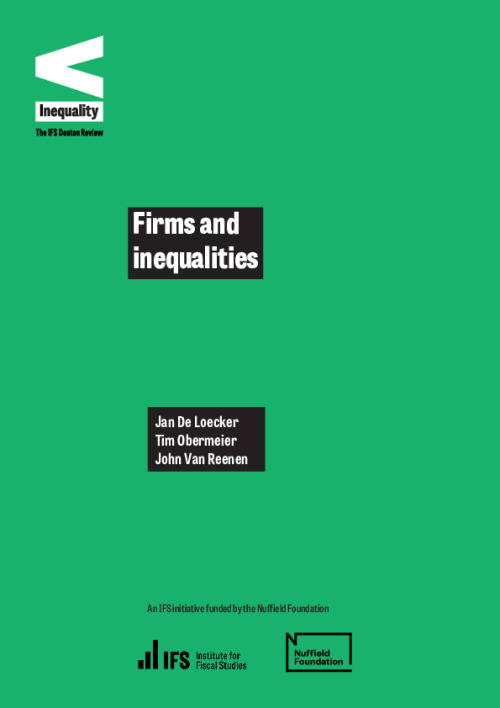There have been some dramatic changes in the business landscape in American firms over the last four decades that have been extensively documented by researchers and are the subject of much public debate (e.g. Van Reenen, 2018; Akcigit and Ates, 2019). In broad terms, one could summarise many of these trends by saying that firm inequality has increased – companies are looking increasingly different in terms of their productivity, wages, markups and size. These changes have been accompanied by several worrying trends such as declining productivity growth, stagnating real wages (especially for low-educated workers), rising markups, a falling share of labour in GDP and declining business dynamism (e.g. the share of workers in young firms has declined).
There are a large number of possible explanations for some (or all) of these trends. Broadly, some authors stress factors that are common across countries such as technological change and globalisation (e.g. Aghion et al., 2019; Peters and Walsh, 2019; Hsieh and Rossi-Hansberg, 2019; Baqaee and Farhi, 2020; De Ridder, 2020). Others point to US-specific factors such as weakening anti-trust enforcement and the erosion of labour market institutions such as the minimum wage and unions (e.g. Philippon (2019) and Stansbury and Summers (2020) respectively). Of course, it is very likely that these forces interact with each other. Take the presence of technological change in a rapidly globalising world, where firms source from highly complex supply chains across the globe, while at the same time potentially selling to a much larger potential pool of consumers. Changes in technology have enabled companies to trade in larger markets and fragmented production in global value chains. This has differential implications for local labour and product markets. Certain countries might find themselves as the beneficiaries of this process, while others (at least relatively) are mostly absorbing the negative shocks. Even within a country, the ‘China shock’, for example, displaces manufacturing jobs in local US labour markets (see Autor, Dorn and Hanson (2016)), but there are other places where firms and people benefit from having access to cheaper final and intermediate goods (e.g. Jaravel and Sager, 2019). Recent empirical work has shown the benefits from increased globalisation in lowering the cost of production (a standard ‘gains from trade’ argument). However, firms with market power will capture part of this cost saving, and this will give rise to increasing dispersion in firm performance, and dynamically can further widen the gap between firms, ultimately giving rise to some of the facts mentioned above (see World Bank (2020) for a discussion in the context of global value chains).[1]
Studying whether these trends have also occurred in Britain is important for two reasons. First, such developments can have important implications for overall UK inequality. To give some examples: (i) rising dispersion in firms’ productivity translates into increasing wage inequality between those employed in high- versus low-productivity companies; (ii) a lower labour share means falling pay or jobs for a given level of GDP, as well as higher household inequality (as capital income is more unequally distributed than labour income); and (iii) rising markups imply higher prices for a given level of marginal costs (or that less of any cost falls gets passed on to consumers), reducing living standards.
A second reason for studying UK business trends is to help assess the explanations of such economic shifts. If the trends are just US-specific, then this suggests that American institutions are more likely explanations than global factors such as technology or trade that broadly affect all countries. While several papers take an international approach to these trends, or have studied a particular economy, there have been few ‘deep dives’ into what the UK experience has been like and, to our knowledge, that cover a wide range of business sector outcomes. The primary purpose of this chapter is to summarise what we know about these trends in the UK. We draw on several data sources, in particular Historical Orbis (HO), a relatively new panel of the population of incorporated firms since the mid 1990s. We also consider more traditional administrative data sources from the Office for National Statistics (ONS).
We find that almost all of the US trends are present in the British data, although the UK information is generally not as rich as that in the US. In particular, we document at the micro level increasing between-firm differences in productivity, wages, size and markups, similar to those in America. Generally, these changes appear to be stronger in the top half of the distribution, with a widening of the upper tail as ‘superstar’ firms pull away from the rest of the pack. Similarly, at the macro level, the UK has experienced a rise in aggregate markups (like the US), slower growth in productivity and wages since the Global Financial Crisis (more dramatically than in the US), and a fall in the wage share of GDP since 1980 (much less stark than in the US).[2] UK entrepreneurship trends in the UK are more ambiguous.
Key findings
- There is huge inequality between firms. In the UK, only 0.1% of businesses have at least 250 workers, but in 2019 these companies accounted for almost two in five of all jobs and just under half of aggregate turnover.
- In the last few decades, dramatic changes have been documented in the business landscape in the US. These include rising productivity inequality between firms, higher aggregate markups (of price over variable costs), a growing dominance of big companies, a fall in the labour share of GDP and declining business dynamism.
- Most of the same empirical trends seen in the US have occurred in Britain since (at least) the mid 1990s. There has been an increase in the firm-level inequality (especially in the upper tails) of productivity, wages, markups and labour shares.
- The UK has had little productivity growth since the Global Financial Crisis in 2008–09. This has been a drag on median and mean real wages, which had barely recovered to pre-crisis levels by the start of the COVID-19 pandemic.
- Aggregate markups have risen since at least the mid 1990s. The labour share of GDP has fallen since the early 1980s, although this fall is less dramatic than that in the US.
- The similarity of the UK and US trends suggests that common trends in technology or globalisation have been driving these changes, rather than country-specific institutions or policies.
- Inequality between firms is less of a concern than inequality between people. However, it can signaleconomic problems, such as a slowdown in the diffusion of ideasbetween leading and laggard firms, and can foster higher wage inequality.
- We suggest policy options in response to these trends include modernising competition rules to deal with the growth of ‘superstar’ firms and strengthening the bargaining power of workers.
[1] De Loecker et al. (2016) present evidence of rising markups during the drastic trade reforms in the Indian manufacturing sector, precisely through the incomplete pass-through of lowering input tariffs. More generally, productivity improvements may be disproportionately captured by firms rather than workers and consumers.
[2] See Gutiérrez and Piton (2020) and Teichgraeber and Van Reenen (2021). The relationship between the aggregate labour share and measures of profitability is a complex one, even putting all the notorious measurement challenges aside (see Van Reenen (2018), Koh, Santaeulàlia-Llopis and Zheng (2020), Autor et al. (2020) and Barkai (2021)). See subsection headed ‘Connecting labour and product markets: a simple framework’ in Section 4 for more discussion.











